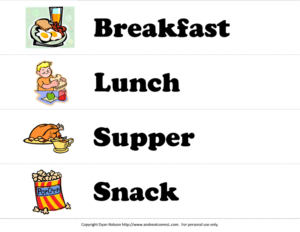Understanding Selective Eating
Having a selective eater can be one very difficult aspect of having a child with autism. One of the diagnostic criteria for autism is restrictive and repetitive behaviors and interests. Eating the same foods is an example of this. Autistic children are 5 times more likely than neurotypical children to exhibit challenging meal time behaviors (Autism Speaks). This includes narrow food selections, ritualistic behaviors around food and temper tantrums related to mealtime. Selective eating occurs in 10% – 35% of neurotypical children, while the prevalence of selective eating occurs in 46% – 89% of children with autism (Association for Science in Autism Treatment). Neurotypical children will eventually eat differently when there is not another choice, or if they get hungry enough; autistic children likely won’t.

There are many different reasons why a child can be a selective eater. Taste is one of the five senses, so many children with sensory processing issues may experience sensitivities to the flavor, texture, color or smell of food. This results in preferring a narrow selection of foods. People with autism likely already have a restricted range of interests and this can carry over into their eating habits. Sometimes it can be difficult for children to sit down and focus on one task – including eating a meal.
Medications can cause disruptions in diet as well. Some medications may increase or decrease appetite, some may affect the absorption of vitamins and minerals, while some can cause constipation. Autistic kids’ limited diet and activity levels can contribute to constipation as well. Your child might be experiencing gastrointestinal distress and have trouble articulating that to you, further contributing to food selectivity and meal-time challenges.

Another cause of selective eating can be motor issues with the mouth. It could be difficult for your child to chew their food and/or swallow. There are activities and exercises to improve oral motor issues. Speech language pathologists and/or occupational therapists works on building strength, endurance, coordination and movement in the mouth, including lips, jaw, tongue and cheeks. Once oral motor skills improve, so can eating.
Selective eating can lead to vitamin and nutrient deficiencies. The National Institute of Health says that most children with autism tend to have thinner bones than children without autism, particularly in boys. Most kids prefer high carb and high fat foods and have little to no preference for fruits and vegetables. They want the same food at the same time presented in the same way. The rigidity of autism also makes it hard to try new things – including food. Just as easily, your child can become preoccupied with a specific food.
Increasing Food Variety
Here are some different techniques you can use to help your child try new foods. Remember, what works for one child may not work for the next.

- Explore food. Have your child pick a new fruit or vegetable at the store. At home, let them touch it, smell it, and even lick the item. Take them to a farmers’ market or garden and show them where their food comes from. Have them help you cook. Expose your child to new foods before they hit the table. These baby steps familiarize your child with new foods and create curiosity in a low-pressure way.
- Pea-sized bites encourage children to try tiny portions of new food, rather than consuming a pile of it. This eases the child into the new flavor/texture while repeated exposure eventually lessens resistance, and your child will learn to accept the new food. Once your child has accepted the new bites, gradually increase the serving size. The more your child is exposed to a food, the sooner they will accept it.
- Start with similar foods that your child already enjoys. For example, if your child likes pudding, try yogurt. Pairing a new food with a preferred food can also help your child try new foods. Introduce only one new food at a time. Sometimes putting a new food on its own plate can help.

- Play with food. Exposure to new foods in a fun way creates positivity and fun around the new food. Try making things out of food, painting with food, making faces and explore other ways to get creative.
- Try the same food in a different way. Your child might not like roasted potatoes, but maybe they will like mashed potatoes. Maybe the top of broccoli has a weird mouth feel to your child, so let them eat the stems. Try blending foods to create a smoother texture. If your child doesn’t like bananas, try making a strawberry banana smoothie. Try scrambled eggs instead of over-easy. Try zucchini noodles instead of a zucchini.
- Offer choices. If you want your child to eat a vegetable, let them pick between what’s in the fridge – carrots, green beans, broccoli, cucumber and peas. This allows your child to feel more in control about their mealtime.
 Positive reinforcements are used to increase a desired behavior. This includes not just trying new foods, but mealtime behavior. Restrict access to the food time reinforcers so they will keep motivating your child to try new foods. They should only be used when your child accepts a new food.
Positive reinforcements are used to increase a desired behavior. This includes not just trying new foods, but mealtime behavior. Restrict access to the food time reinforcers so they will keep motivating your child to try new foods. They should only be used when your child accepts a new food. - Use visuals. This could be a schedule, pictures of food to be expected, or a token board counting how many bites must be taken before your child can gain access to their preferred activity. Try videos of other children eating the foods you are asking yours to try.
- Ignore inappropriate mealtime behaviors. This requires a lot of patience and will be frustrating, but it is for the best. Your child’s behaviors may increase at first because you aren’t responding to their methods, but eventually the inappropriate behaviors will decrease. Don’t forget to provide positive attention to good behaviors you want to see more of.
 Create a meal schedule. Creating a routine can lessen the anxiety around mealtime. Those with autism thrive when they have structure. It can also be used to make sure there is ample time between meals and snacks, thus increasing your child’s hunger for mealtime. Try limiting snacking between meals.
Create a meal schedule. Creating a routine can lessen the anxiety around mealtime. Those with autism thrive when they have structure. It can also be used to make sure there is ample time between meals and snacks, thus increasing your child’s hunger for mealtime. Try limiting snacking between meals. - Collect data. Keep track of what new food, the amount, and how your child responds. Over time, you will be able to see when it is time to increase the amount of food, or you may realize there has not been an improvement and you may need to change your methods and seek additional help from qualified professionals.
Resources
Here are some data sheets for tracking your child’s food preferences and mealtime habits.
Association of Science in Autism Treatment, National Institute of Health, and Autism Speaks have some great information on food variety for autism.


 Positive reinforcements
Positive reinforcements  Create a meal schedule.
Create a meal schedule.